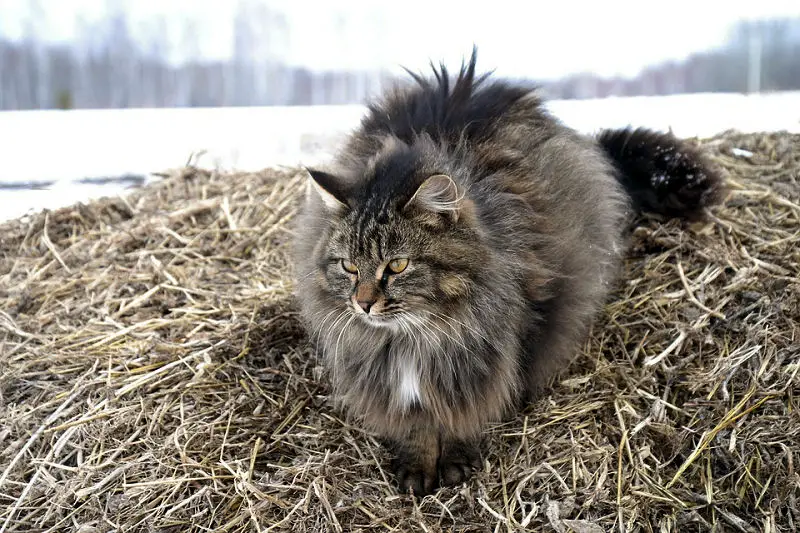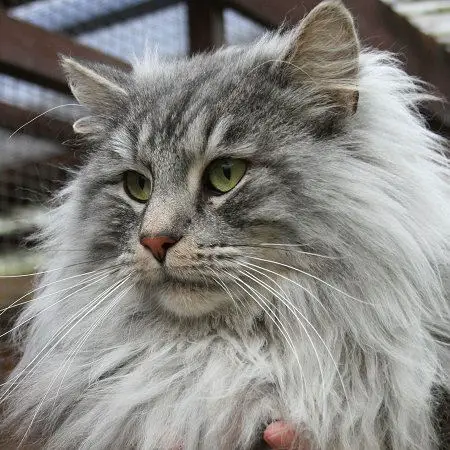We felt it was time for another cat breed spotlight and we chose the stunning Russian Blue to showcase. Following is a guest post that we hope you’ll enjoy…
It only takes one glance to fall in love with a Russian Blue, so it’s no surprise these cats were featured in some of England’s earliest cat shows. Back then, they were known as Archangel Cats, named after the Russian Isle from which they derived.

These cats originated as a natural breed, meaning the breed wasn’t created by man, but towards the end of WWII Russian Blues were going extinct. Many breeders began using cats with similar features to keep the bloodline alive, such as Siamese or British Blue cats. This gene influence resulted in a change of fur texture that later took years to correct. Eventually, using mostly Scandinavian bloodlines, the breed eventually found it’s plush, silvery-blue coat again. This change in reproductive genes gave us the green-eyed beauties we call Russian Blues today.
It took hundreds of years for this breed to migrate to the U.S., but their popularity continues to grow as we learn more about their unique personalities. Whether you’re new to raising Russian Blues, or a long-time lover of the breed, creating the perfect living environment for them can be tricky. From characteristics to care, this guide has everything you’ll need to know.

Characteristics
The Russian Blue is a very intelligent breed of cat. They love to play, but you won’t find them chasing their tail or lost in the shadows. They enjoy sophisticated play. Most comfortable in quiet, stable environments, these cats do not take kindly to change. If you have young kids, or are planning to move around, this may not be the best breed choice for you.
Russian Blues are known to be shy around strangers, but are very affectionate to their loved ones. They are generally soft spoken, unless hungry, and their shy personality can be difficult to introduce to a new lifestyle. It is important you socialize your Russian Blue with new people and pets slowly. Especially pets they will be living with in the future. When bringing your Russian Blue home for the first time, I recommend confining their new living space to a single room for a few days. They are less likely to feel overwhelmed in a smaller space.

This is especially crucial if you have additional pets. Other animals in the house will pick up on your new family member’s scent in a non-threatening way. If you start by putting all of your animals in the same room, your older pets may perceive the new cat as invading their territory.
While giving your Russian Blue daily attention is crucial, don’t handle the cat constantly. They can easily feel overwhelmed from too much contact. If he or she will be home alone during long work days, remember to buy toys. They love to play and can even fetch! With some cats attempting to train is pointless. Russian Blues are very smart so correcting misbehavior is possible. Just remember, consistency is key.
If you’re leaning towards a Russian Blue for your emotional support animal know that these cats are very sensitive to their owner’s moods. It may be better to find a cat that stays happy regardless of your emotional state. You won’t find one softer than a Russian Blue though. Remember our two sisters Xafi and Auri? Their shiny blue coats and turquoise eyes can be hard to forget. Traces of this breed are often distinguished by eye color and shape, as well as other behavior features. This medium-sized cat has a fine bone structure supported with solid muscles. This allows them to jump high and far, often surprising their owner.

Care
Your Russian Blue will thrive in a hygienic, consistent environment and can live anywhere from 10 to 15 years. Like most pets, Russian Blues love to eat, and they’ll trick you into overeating if they can. It’s important that you stay strong and refrain from giving handouts or extra snacks as this breed can go from looking fit to overweight in just a few weeks. Achieving the reverse effect, however, is much harder. With that said, the food you do provide should be substantial. Look for brands high in protein and fat. Remember that Russian Blues are descendants of big cats — lions, tigers and pumas (oh my). You wouldn’t feed any of these felines a vegetarian diet, so don’t be surprised if your Russian Blue goes hungry without meat.
[clickToTweet tweet=”A Tribute to The Russian Blue Cat – Radiant and Regal” quote=”A Tribute to The Russian Blue Cat – Radiant and Regal”]
In nature these cats hunt similar prey every time they eat, resulting in little to no change in their diet. Keep this in mind when planning a meal schedule. To determine how much food your Russian Blue needs, I advise consulting a vet. There are two important questions to ask yourself. First, will your cat be living in or outside? With this breed I suggest keeping them indoor, only because on average this seems to be their preference. Secondly, has the cat been spayed or neutered? Your answer to these two questions will determine how much and how often your cat should be fed.

The more treats you give, the less interested they will be in their daily diet. If you notice loss of appetite see a vet immediately. These cats are at high risk of liver failure if malnourished. If you consider changing food brand or type, do not do so lightly. These cats seem to reject new food more often than other breeds. Monitor their sensitive stomachs after starting a new brand to assure they can handle the new food. Another diet aspect you’ll want to watch is water intake. Most cats don’t drink enough water so it can be a good idea to mix a little into their food.
Some breeds need several supplements to stay healthy. These cats are lucky in that their health is easy to manage. The only supplement you should need is for hairball control (tick and flea protection is always a good idea too). You’ll want to compare health insurance quotes to determine the cheapest line of care for your pet, especially as he or she gets older.

Earlier I mentioned hygiene, an important aspect to consider. You should keep the litter box cleaner than usual. Russian Blues are neat freaks so to speak. If it doesn’t meet their standards, they won’t even walk into the box. Keeping your cat clean is just as important as maintaining a hygienic environment. You should check their ears and eyes often for allergies or infection. It is recommended you brush their teeth daily, but only doing so two or three times a week won’t hurt.
Cats that are trained to not scratch furniture will need their nails clipped more often. Conveniently, their translucent nails make it easy to see the vein running behind the nail, do not clip this vein. You’ll have to brush your Russian Blue more often too, probably once or twice a week to manage the shedding. Use a medium toothed, metal comb for best results.

You’ll notice your Russian Blue seems happy as long as you are. They appreciate a pat on the head here and there, and enjoy a window seat for dreaming of bird snacks.
Guest Post Author Bio
Jayson is a writer from Phoenix, Arizona who loves pets! He is a proud owner of a beautiful kitty and wants to share the joy of pet ownership with others. He hopes to encourage people to keep their pets happy and healthy year-round. You can follow Jayson here:
LinkedIn: https://www.linkedin.com/in/jayson-goetz-4a1552129
Instagram: https://www.instagram.com/jaysongoetzz/?hl=en
Photo Credits
All photos taken by permission from the adorable IG feed of two Russian Blue boys named Walter and Winston. Follow these two handsome rascals on their daily escapades at: @walter.and.winston





They’re beautiful, with a personality to match. Makes me want to buy one. I don’t have kids, and they’d be perfect for me. They’re certainly worth a purr.
I’ve had a Persian slightly mixed with Angora, a mixed one, and now three feral cats. They’re great too. I tell people they’re pure feral, with papers. They may not look so fancy, but they’re beautiful rescues who chose me by leaping through the window of my first floor apartment. Any ownerless four legged creature who gets into my apartment will get to stay, excluding mice and rats.
My Russian blue cat is very loving to every animal I’ve ever brought home! He’s never thrown a fuss about it, only thing I do notice on him is separation anxiety with me, he has strong emotions when he lost my mom and started attacking people but never me nor the other 2 cats. I did adopt a kitten while working full time and he helped raise her on what I couldn’t do, the parts that needed to come directly from a cat. He did an amazing job and to this day he still watches out for her as that’s his pride and joy. When I’m sick him and my tuxedo cat take turns staying by my side so I’m never left alone. My tuxedo cat will scream at the top of his lungs until everyone is in the room with me. I’m a reiki master so I made all my cats reiki and my Russian blue is the best healer I have!
I have a Russian Blue I rescued when he was about 2 maybe 3 months old……..the owners wife got him n her husband wanted a dog.n was going to put my furbaby to sleep the following day…( they mistook ..my Blue as a grey cat n that was it he was not wanted ) so I took him home….n the following day to the Vets n had everything done….. shots… n when the time was right neutered…, n a chip (in case he got out ) my first trip to the vet I learned he was a Russian Blue I had never heard of the breed n so I went home n look them up n read on everything about them….( the people had named him Bluejay I dropped the Jay n kept the Blue ).. they had allowed him to run free in a trailer park….Once home with me I trained him to a harness n leash too about a week b cuz he’d flop on the floor, but after a week he adjusted to the harness (on n off thru out the day) n then I took him out n we now go out every single day (weather permitting) he knows what the harness is… ….I love all animals…. I love n adore my Russian Blue ….Blue is great with other animals….Blue sleeps with me…….He is the star of the neighbor..he has a fan club of mostly kids with their parents when they walk by our yard ..he runs towards them to be patted….. BUT!!!! there are some people he will not go near ,I wont force him to do so….. I trust their instincts, … we have been together for 10 yrs now…. he is still very healthy ..has his yearly visits to the vets (today as a fact for his yearly
shots n check up.. he is still lean n very healthy ) When I m not feeling good Blue stays with me most of time…. ..my Blue is my life n is so spoiled ..but he (as well as them all) deserve to be treated like Royalty .. Thanks for allowing me to share
Hello
My name is Katina
I would love to own 1 or 2 Russian Blues
I love them!
How do go about this process?
I live in a house; alone and on a lake in Oceanside Ca
Kittens up to 1 year old
Thank you in advance
Katina
I would love to have a Russian Blue Kitten
I owe 2 pure breed RB (girl and male (brother and sister) and you need to find a good breeder. They are expensive but worth every single purr/penny. Be careful of the many many scammers online. My husband and I almost got scammed. We now know how to detect them. Like Jeannette SUTHERLAND, you also may be lucky finding a pure breed one from a shelter. Who knows.